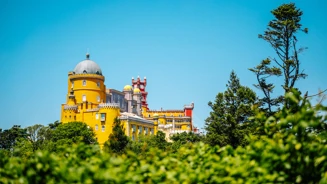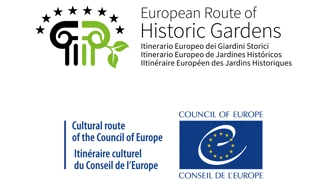The History of Park and National Palace of Pena

The history of this magical site reaches back to the 12th century, a point in time when there was a chapel dedicated to Our Lady of Pena here. On this same location, King Manuel I ordered the construction of a Monastery, the Royal Monastery of Our Lady of Pena, subsequently handed over to the Hieronymite Order.
The earthquake which struck Lisbon in 1755 left the monastery practically entirely in ruins. However, even while stricken, the Monastery remained active and it would only be almost a century later, in 1834, following the abolition of religious orders in Portugal, that it was abandoned. The Park of Pena still retains areas that recall this period, for example, the Grotto of the Monk, the place where the monks went into secluded retreat.
Two years later, in 1836, Queen Maria II married Ferdinand of Saxe-Coburg and Gotha, a prince in this noble household and nephew of the ruling Duke of Coburg, Ernest I and King Leopold I of Belgium. According to the nuptial contract, Ferdinand was bestowed with the status of King-consort.
Ferdinand II was one of the most cultured men of 19th century Portugal. A polyglot, he spoke German, Hungarian, French, English, Spanish, Italian and, of course, Portuguese. In his childhood, the then Duke of Saxe-Coburg and Gotha received a thorough education in which the arts, especially music and drawing, played fundamental roles. During his entire life, he maintained a deep connection with the arts whether as an artist, collector or sponsor and becoming known nationally as the King-Artist.
Shortly after his arrival in Portugal, he fell for Sintra and acquired, from his own personal fortune, the Monastery of Saint Jerome, then in ruins, as well as all the lands surrounding the property. This sixteenth century monastery held an enormous degree of fascination for the king stemming both from his Germanic education and the romantic imaginary prevailing at the time that attracted him to the hills and the aesthetic value of the ruins. The original project was simply to restore the building as the summer residence for the royal family but his enthusiasm led him to opt for the construction of a palace and extending the pre-existing construction under the supervision of Baron Wilhelm Ludwig von Eschwege, a mineralogist and mine engineer who was then residing in Portugal. The building is circled by other architectural structures that appeal to the medieval imaginary, such as the parapet paths, the lookout towers, an access tunnel and even its own drawbridge. The palace incorporates architectural references displaying Manueline and Moorish influences that together produce a surprising scenario recollecting “a thousand and one nights.”
In the park, reflecting the expression of the romantic aesthetic combined with the search for exoticism and the untamed wildness of nature, the king designed twisting paths that would take visitors off in discovery of key reference landmarks and where they could best appreciate some stunning views: the High Cross, the Temple of Columns, St. Catherine’s Heights, the Grotto of the Monk, the Little Birds Fountain, the Queen’s Fern Valley and the Valley of the Lakes. Along the pathways, in keeping with his interest as a collector, he planted tree species from every continent and in the process rendering the 85 hectares of the Park of Pena as the most important arboretum existing in Portugal. Among the many highlights are the Asian camelia collections introduced by Ferdinand II into the Park of Pena in the 1840s and that have become a landmark in the Sintra winter and the cause for dances and festivals. The exotic groves frame pavilions and small constructions to great scenarios of unquestionable natural beauty that are also of great historical and heritage importance.
Following the death of Queen Maria II in 1853, Ferdinand would later marry Elise Hensler, an opera singer and the Countess of Edla. Together, they built the Chalet of the Countess of Edla located in the Park of Pena. This two-storey construction, of Alpine inspiration, contained a strong scenic component and maintained an expressive visual relationship with the Palace.
The second phase of occupation of Pena by the Royal Family saw the presence of King Carlos I (1863-1908) and Queen Amelie of Orleans (1865-1951). These monarchs would spend part of the summer season in the palace before then moving onto the Citadel of Cascais for further vacations. Their son, Manuel II, also spent long periods in this palace where he maintained his former princely chambers on the noble floor of the Turret Tower while also turning to the former chambers of his father on the lower floor of the cloister to attend to his official functions.
Queen Amelie was in the Palace of Pena when taken by surprise by news of the Declaration of the Republic on 5th October 1910, and where she departed from for Mafra to meet up with mother-in-law, Maria Pia, and her son, Manuel, before embarking on the royal yacht D. Amélia in Ericeira and setting sail for Gibraltar.
The Palace of Pena was classified as a National Monument in 1910 and ranks as the single most important site in the Cultural Landscape of Sintra, classified by UNESCO as World Heritage in 1995.
In 2000, Parques de Sintra took over the running of the Park of Pena before, in 2007, the company became responsible for managing the palace. In 2013, the National Palace of Pena became a member of the European Royal Residence Network.
Over the years, Parques de Sintra has undertaken constant work within the framework of conservation, restoration and revaluation of the vast heritage incorporated into the Park and Palace of Pena, with highlights including the reconstruction project for the Chalet of the Countess of Edla – distinguished in 2013 with the Europa Nostra – European Union Award for Cultural Heritage in the Conservation category – and the complete restoration of the Great Hall in the Palace of Pena.
The Park and National Palace of Pena is integrated in the "European Route of Historic Gardens", within the “Cultural Routes of the Council of Europe” since 2020.
The Cultural Routes programme, launched by the Council of Europe in 1987, demonstrates in a visible way, by means of a journey through space and time, how the heritage of the different countries and cultures of Europe represent a share cultural heritage. The Cultural Routes put into practice the fundamental values of Council of Europe: human rights, cultural democracy, cultural diversity and identity, dialogue, mutual exchange and enrichments across boundaries and centuries. As of 2020, there are 40 certified Cultural Routes of the Council of Europe (www.coe.int/routes).

